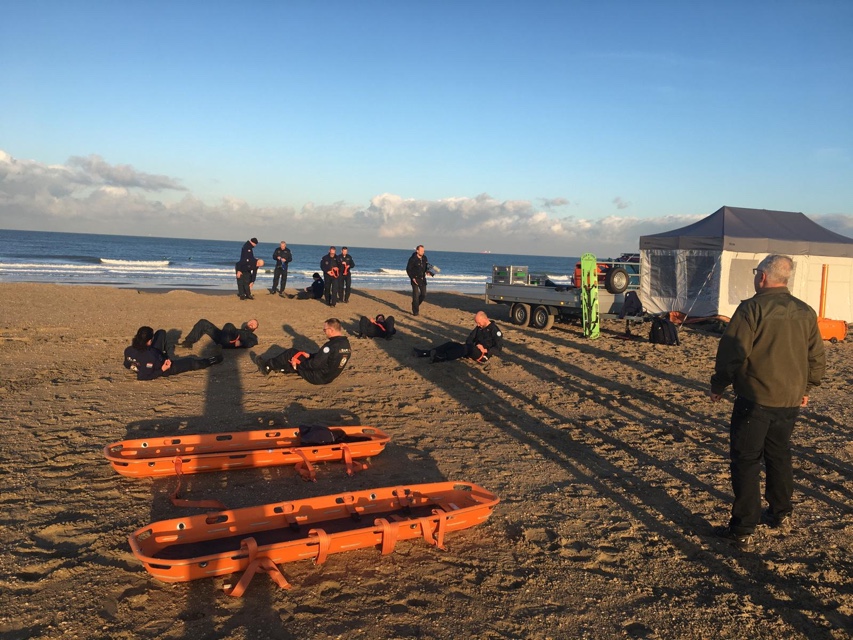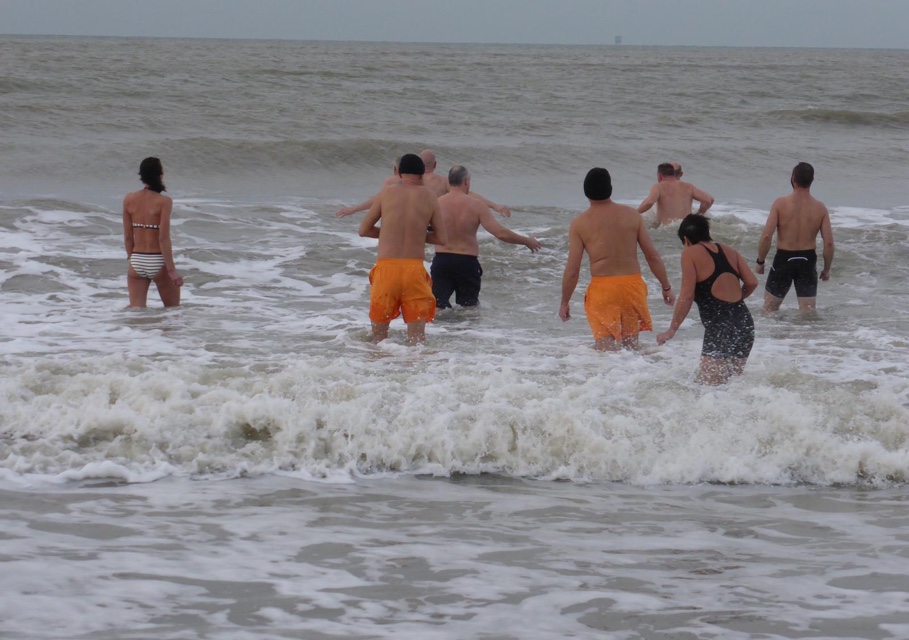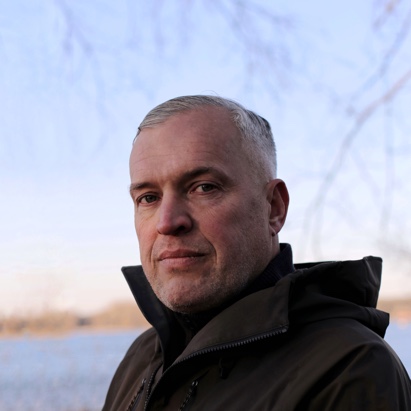On Thursday December 12, 2019, I organised a special practice day on Scheveningen beach on behalf of Thomas Eckhardt, USAR.NL Medical Manager USAR.
USAR-ESTONIA
Our contact dates from November 2015 in Estonia, when we met during the so-called EST-USAR IEC INSARAG Classifiers programme for the Estonian USAR team. They were assessed for the Estonian USAR team on their qualities and organisation by experts from other USAR teams, in order to be admitted to the USAR community. This was realised.
“Classification is a peer review where best practices from the network are being shared”.
Terje Skavdal, former secretary of INSARAG Geneva, the umbrella organisation of all USAR teams, had invited me to attend as an observer. During the classification in Estonia, Thomas Eckhardt indicated that he wanted members of his USAR team to be trained by me, which was followed up.
MAIN GOALS
My assignment was to train a group of twelve USAR nurses in an unusual way, which would enable them to operate better under extreme circumstances. Extreme cold, heat, wetness, altitude, sleep deprivation, in combination with a lack of acclimatisation and exposure to large-scale human suffering and destruction, demand a lot of the absorbency and resilience of both the team as a whole and its individual members.
Previous experiences showed that these specialist nurses, who work in an ambulance service in daily life, have difficulties in harsh climatic conditions in the deployment area.
TRAINING DAY
It was an exciting assignment. During the preparation I consulted regularly with Thomas Eckhardt to get the questions and goals clear so I could deliver a custom-made training.Logistically I was assisted by Marco Boulogne and his team from USAR/fire brigade/IFV, so I could submit my requests and get them on time. At the break of dawn I arrived at Scheveningen beach, where one of the logistic employees was already present with a 4 x 4 and a large trailer with materials. Not much later we were with five men on the spot. Together we set up the USAR tent, near the high tide mark, where the afternoon programme was to take place. Once finished, I hurried to the side terrace of Beachclub Hartbeach where the morning program would start.
This is a nice beach bar where I regularly go early in the morning to meet up with a group of friends who are winter swimmers to go into the sea together.
EXPERIENTIAL LEARNING¹
From 9 a.m. to 9.15 a.m. was the entry and the registration of the twelve nurses. The Defence physician Maarten Leeflang I had invited arrived as well, his role would be that of an observer.
The programme started. After the welcome by Thomas Eckhardt I took the floor and after a brief statement of today’s goals, I distributed a Combat Application Tourniquet (CAT®) and requested the participants to go outside to the high tide mark.
PRACTICE
The physical cannot do without the cerebral, and vice versa, the body is our vehicle and must be able to function optimally for the tasks set and perform assignments to the best of our ability.
When I arrived at the tent, I divided the group in two, each team had one stretcher at its disposal and one member per team acted as victim.
From there, the two teams had to run more than hundred metres and then return the same way. Once on site, The participants were assigned to perform a number of cross-fit exercises. Finally I blew a whistle and shouted that each of them had a massive haemorrhage in the lower leg and had to apply a tourniquet on themselves within 30 seconds, which I then checked on efficiency and effectiveness.
PREMISES AND QUESTIONS
Once back inside, everybody was warmed up and ready for seven statements with regards to preparation, working conditions in the deployment area and to discuss professional requirements in plenary.
The group was then divided into four working groups that studied six fundamental questions related to deployment in disaster areas.
Afterwards, at lunch, the results were discussed in plenary so that these could be included in order to streamline the organisation, logistics and implementation even better.
TACTICAL BREATHING & STRESS MANAGEMENT
Although stormy conditions had been forecast for this day, the conditions turned out to be optimal: the sun was shining, it remained dry and the wind was moderate in strength.
The Scheveningen Rescue Brigade, part of the Fire Department, Safety Region Haaglanden, was on the spot with a vehicle to keep an eye on us when we went into the sea. Proper preparation and implementation means you observe the safety of the participants as well as possible.
Inside the tent there was just enough room for seventeen people to give an elementary presentation of the physiological system in relationship to stress management. Then I gave some breathing exercises, that were carried out on rubber mats next to each other. How inspiring is that!
TASK 1
In swimming trunks/bathing suits we entered the somewhat turbulent sea. Some got out immediately again upon first contact with the cold water, but returned a little later to fully immerse themselves. Breathing is disrupted and that is precisely the purpose; it subsequently has to be centered again in the abdomen to the level of the navel.
TASK 2
The group was divided in two again, each team had a stretcher to its disposal and per team one member acted as a (actually) cooled off victim. First, the ‘hypothermic’ patient had to be wrapped up and protected against further hypothermia. They had the choice between a Hypothermia Prevention and Medical kit (which I had received especially for this occasion from Special Medics in Utrecht) and the Blizzard EMS Trauma Blanket, purchased from the company Innoventa in Houten. The wrapped up near drowning persons had to be transported by the two teams over a hundred metres before they returned the same way.
TASK 3
Once back in the heated USAR tent, the last assignment of the day was to put together a number of stitches on a practice skin with the limited resources that were available.
Once you have become cold, your fine motor skills have diminished, as has your consciousness to a lesser or greater extent, it is very tricky to perform a number of complex exercises that require fine motor skills.
It’s all about being aware and observing your physical reactions, so you can see what you can influence directly by means of your breathing and being aware of the here and now.
EVALUATION AND CLOSURE
Slightly warmed up by a cup of hot water with fresh ginger, we walked back together to Hartbeach, while the logistics people returned to take down the tent and clean up.
The day was unanimously evaluated by the nurses as very successful and worth repeating.
That is a good result and really says something, as these people are specialist professionals, who are deployed in remote earthquake areas and have the primary task to watch over the health and fitness of the team and deliver secondary medical help to earthquake victims, not an easy task to deal with. For me, it is a highlight to share my expertise and experiences with them and to help them to enter a disaster area even better equipped.
¹ ‘Experiential learning’ includes both soft skills and hard skills, for example: how can I communicate effectively with a team, and how do I apply adequately a tourniquet to a person with catastrophic bleeding in one of the extremities?
This method was taught to me more than twenty years ago by instructors from the American organisation Wilderness Medical Associates, where I was trained as a Wilderness Emergency Medical Technician/EMT and subsequently gave trainings in for several years. The Experiental Learning method was originally developed by the German pedagogue Kurh Hahn, the co-founder of Outward Bound. A proven method that optimes the learning process.
.jpg)


.jpg)
.jpg)

